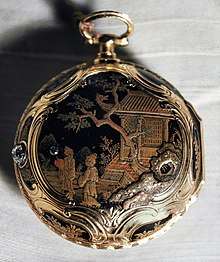Japanning
Japanning is a type of finish that originated as a European imitation of Asian lacquerwork. It was first used on furniture, but was later much used on small items in metal. The word originated in the 17th century. American work is more often called toleware.
.jpg)
Although often referred to as lacquer, it is distinct from true East Asian lacquer, which is made by coating objects with a preparation based on the dried sap of the Toxicodendron vernicifluum tree, which was not available in Europe.
Japanning is most often a heavy black "lacquer", almost like enamel paint. Black is common and japanning is often assumed to be synonymous with black japanning. The European technique uses varnishes that have a resin base, similar to shellac, applied in heat-dried layers which are then polished, to give a smooth glossy finish. It can also come in reds, greens and blues.
Originating in India, China and Japan as a decorative coating for pottery, it made its way into Europe by the 17th century. In the late 17th century, high European demand and rumors that higher quality pieces were not exported led to production starting in Italy. Its traditional form used gold designs and pictorials to contrast with the black base colour.

Development in Europe
As the demand for all things japanned grew, the Italian technique for imitating Asian lacquerwork also spread. The art of japanning developed in seventeenth-century Britain, France, Italy, and the Low Countries. The technique was described in manuals such as Stalker and Parker's Treatise of Japanning and Varnishing, published in Oxford in 1688. Colonial Boston was a major center of the japanning trade in America, where at least a dozen cabinetmakers included it among their specialties. In England, decoupage, the art of applying paper cutouts to other items, became very popular, especially the botanically inspired works of Mary Delany.
Wolverhampton and Bilston
.jpg)
Wolverhampton and Bilston were important centres for the manufacture of japanned ware. Trade directories for 1818 list 20 firms of japanners in Wolverhampton and 15 in Bilston.[1] According to Samuel Timmins' book Birmingham and the Midland Hardware District, published in 1866, there were 2000 people employed in the japanning and tin-plate industries in Wolverhampton and Bilston at the time. Japanning firms ranged in size from small family workshops, which often adjoined the proprietor's home, to a few large factories employing over 250 people. In the larger workshops, the production of tin plate and papier-mâché articles and the japanning process all took place under one roof, while small workshops tended to carry out only one or two of the trades, usually tin-plate working and japanning.

At the height of its popularity, richly decorated japanned ware was to be seen in every middle-class home, but from the mid-19th century, this began to change. By the 1880s, the japanning and tin-plate industries were in decline. This was due partly to changes in fashion and taste and partly due to the development of electroplating. In response, makers of japanned ware began to focus on more utilitarian items, including japanned cash boxes. Many turned to other trades, including enamelling, electroplating and the manufacture of copper and brass coal scuttles, fire screens and kettles. By the 1920s, the West Midlands' decorative japanned ware industry had largely died out. Many firms began to supply japanned metal to the newly established bicycle and motor vehicle industries, and some even made their own bicycles. The most successful of these was John Marston, whose japanning factory began making bicycles in 1887. The bicycle manufacturing part of the business quickly became more successful than the production of decorative japanned ware. Marston's wife thought the gilt on the black japanned bicycles looked like sunbeams and the bicycles were branded Sunbeam and their factory was named Sunbeamland.
Japanned metal
Ironware was japanned black, for decorative reasons. It was also used to render it rustproof, suitable for carrying water. A significant industry developed at Pontypool and Usk, shortly before tinplate began to be made in the area. Japanned ware was being also made at Bilston by 1719 and later elsewhere in the area.[2]
Applications
The technique was also developed to protect metal objects such as sewing machines, hand planes, builders' hardware, and in North America, watthour meters made before the mid-1930s. Later, it was used as an insulating film on transformer laminations. It was also used as the substrate for the tintype photographic process.
See also
References
- The history of Wolverhampton, the city and its people http://www.wolverhamptonhistory.org.uk/work/industry/japanning
- M. B. Rowlands, Masters and Men in the West Midlands metalware trades before the industrial revolution (Manchester University Press 1975), 134-136 etc.
Further reading
- Eerdmans, Emily (2006). "The International Court Style: William & Mary and Queen Anne, 1689–1714: The Call of the Orient". Classic English Design and Antiques: Period Styles and Furniture: The Hyde Park Antiques Collection. New York: Rizzoli International Publications. pp. 22–25. ISBN 978-0-8478-2863-0.
External links
| Wikimedia Commons has media related to Japanning. |
| Look up japanning in Wiktionary, the free dictionary. |
- . Encyclopædia Britannica. 15 (11th ed.). 1911.
- Japaning at the Wolverhampton History and Heritage Website